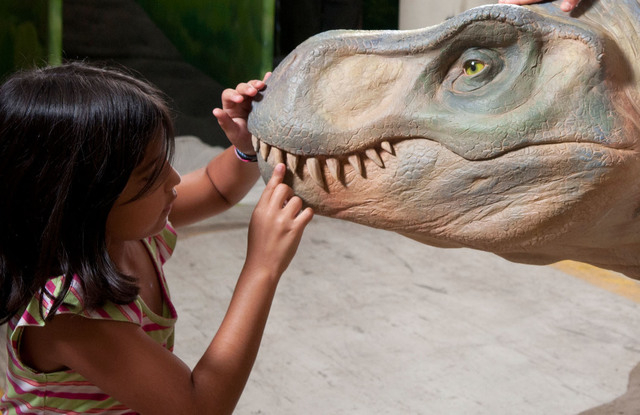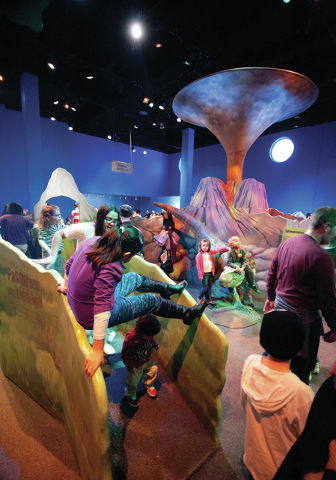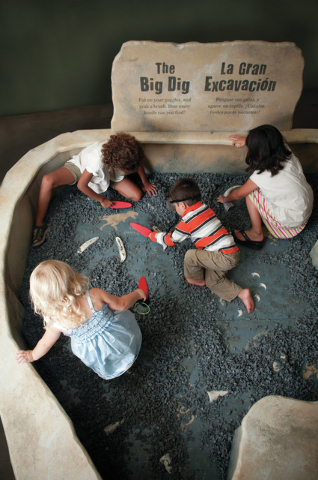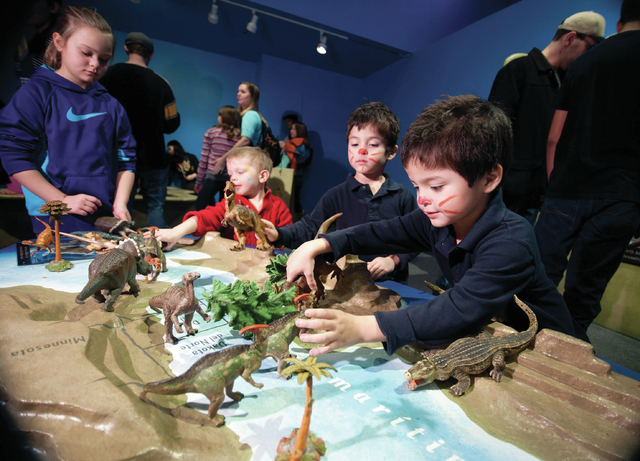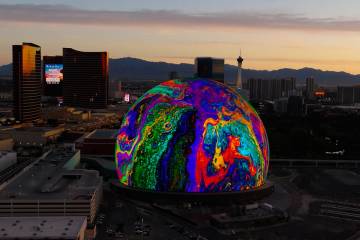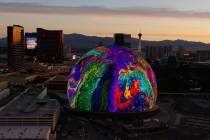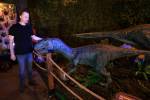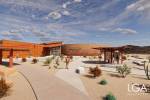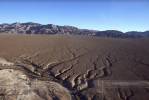Discover dinosaurs, hot and cool
If you thought dinosaurs lived only in steamy tropical climates, think again.
Or, better yet, explore two contrasting dinosaur environments via “Dinosaurs: Land of Fire and Ice,” which opens a summer run Saturday at the Discovery Children’s Museum.
The touring exhibition, created by the Minnesota Children’s Museum, spotlights very different dinosaur environments — and the very different creatures who populated them.
“Land of Fire and Ice” transports visitors about 70 million years back in time, to the Cretaceous Period, when “a fairly shallow lake” covered “the middle of North America,” explains Mary Weiland, a senior exhibit developer at the Minnesota Children’s Museum, in a telephone interview from St. Paul.
At the time, the lake’s eastern shore touched Minnesota (no surprise there), but its western edge was the Rocky Mountains, Weiland says. (Nevada was underwater, too, but much earlier in time — from 200 million to 400 million years ago.)
Sculpted geographical play tables — complete with toy-sized dinosaurs — enable visitors young and old to explore Cretaceous-period North America.
But it’s the life-size dinosaurs — “four gorgeous, large, touchable dinosaurs,” in Weiland’s words — who command the “Land of Fire and Ice” spotlight.
Residents of the “Fire” side — “a warm ecosystem that we typically think about” in connection with dinosaurs, Weiland says — include the familiar Triceratops and Tyrannosaurus rex.
This exhibit’s T. rex, however, might not be as terrifying as some of his counterparts elsewhere, Weiland says.
“We did have to be careful” about “the mouth on the T. rex,” she says. “We wanted a closed-mouth dinosaur. We didn’t want big, large, scary teeth.”
Meanwhile, the “Ice” side of the show introduces two less familiar dinosaurs: Edmontosaurus and Troodon.
Research — and a PBS “Nova” special — introduced the exhibit designers to these dinosaurs, which “lived in a cold environment,” Weiland recalls. Back in the Cretaceous Period, Alaska “wasn’t quite as cold as it is now.”The discovery of numerous Arctic dinosaurs has prompted scientists to reconsider older theories about the giant creatures living only in tropical climates.
Inspired by the contrast between warm-climate dinosaurs and those from icier environments, Weiland and her fellow exhibit developers sought to “create a playful learning environment” that would focus on both temperature extremes.
In the “Land of Fire” section, the T. rex and triceratops share their prehistoric home with a lava-oozing volcano and a swampy bog.
And, despite the drop in temperature, the exhibit’s “Land of Ice” offers adventures ranging from zooming down an icy slide to hopping across a chilly river’s steppingstones. To say nothing of climbing on, and around, the (relatively) diminutive Troodon.
Visitors can “touch ’em and climb on ’em,” Weiland promises. (To say nothing of photo ops — complete with email options — for kids climbing atop the baby Triceratops or peeking beneath the Edmontosaurus’ long legs.)
In the case of the Troodon, “we have that dinosaur in an environment that includes a nest,” she adds. Which means that kids can “become one of the little dinosaurs and become part of that ecosystem,” thanks to available Troodon costumes. (And in the unlikely event that somebody doesn’t want to impersonate a dinosaur, dragonfly and bee costumes are also available.)
Rounding out the display: a contemporary Field Research Station, filled with re-created “fossils,” where “kids can dig around in a big pit and discover things,” Weiland says. Amateur paleontologists will also have the chance to create fossil rubbings and tracings.
All three exhibit areas “are completely hands-on” and provide “immersive play,” she notes, bringing fun and learning together.
The creation of “Dinosaurs: Land of Fire and Ice” began in 2009 and 2010, when Weiland and her colleagues were “able to test out our ideas” when a prototype of the exhibit went on display for six months at the Minnesota museum.
Following the test run, the current touring exhibit — the museum’s third dinosaur-related exhibit — hit the road in fall 2011 and became “one of our big hits,” Weiland says. (It’s currently booked through 2017.)
That’s hardly unexpected, considering the overall appeal of dinosaurs — and exhibits about them.
“We know it’s just such a popular and fascinating topic,” Weiland says.
After all, “children love animals,” she says, noting that such affection also triggers curiosity about “where did they live, what did they eat.”
The exhibit’s touchable dinosaurs offer up-close-and-personal chances to experience “the shapes, the skin, the horns” of the long-extinct creatures, Weiland points out.
Along the way, exhibit visitors also have the chance to use “critical thinking skills,” she says, from observation to reasoning.
Which is all very well — but can’t possibly compare to the thrill of climbing atop a baby triceratops.
For more stories from Carol Cling go to bestoflasvegas.com. Contact her at ccling@reviewjournal.com and follow @CarolSCling on Twitter.
PREVIEW
What: "Dinosaurs: Land of Fire and Ice"
When: Opens Saturday, May 30, and runs through Sept. 13; 9 a.m.-4 p.m. Tuesdays through Fridays, 10 a.m.-5 p.m. Saturdays, noon-5 p.m. Sundays
Where: Donald W. Reynolds Discovery Center, 360 Promenade Place
Admission: $14.50; free for children younger than 1 and museum members (702-382-5437, www.discoverykidslv.org)



